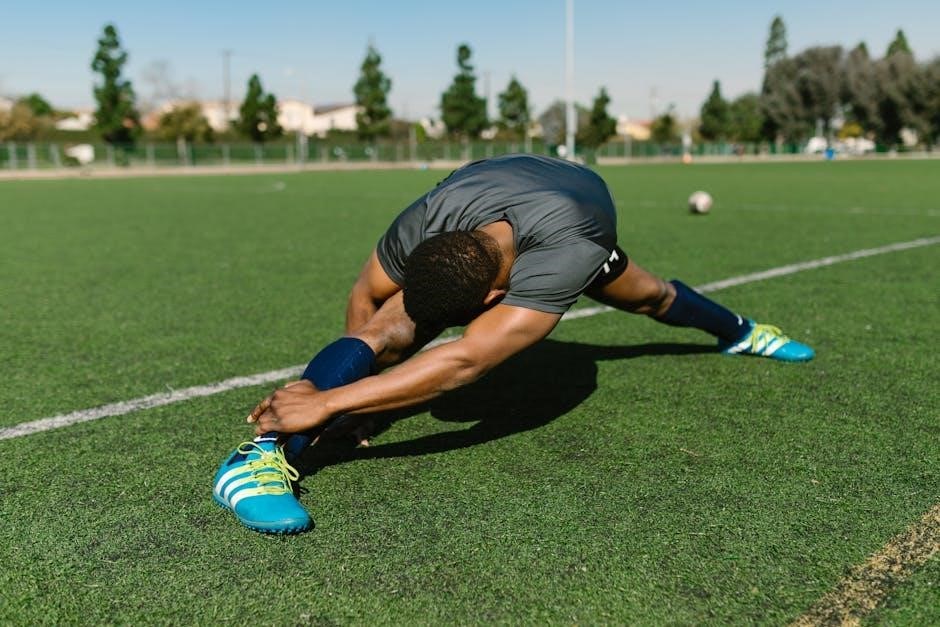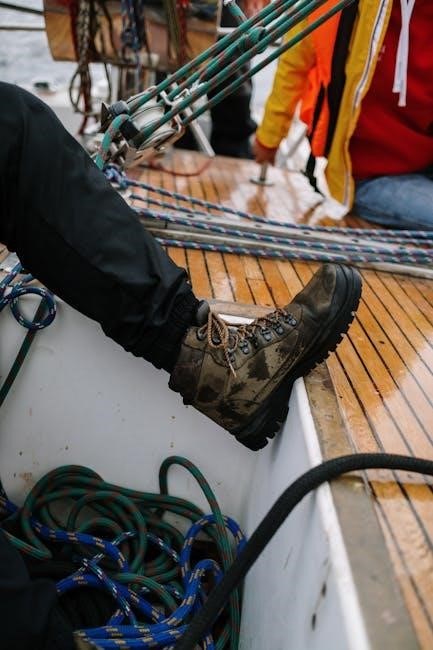A proper boot fit is essential for comfort and performance․ This guide helps determine the right width, ensuring optimal comfort and avoiding tightness or looseness, aiding informed decisions․
1․1 Importance of Proper Boot Fit
Proper boot fit ensures comfort, support, and optimal performance․ Ill-fitting boots can cause discomfort, blisters, or even long-term foot issues․ Correct width accommodates foot shape, activity demands, and sock thickness, enhancing stability and reducing fatigue during extended wear․
1․2 Understanding Boot Width and Its Impact on Comfort
Boot width significantly impacts comfort by ensuring proper toe movement and pressure distribution․ A well-fitted width prevents blisters, hotspots, and discomfort during extended wear․ It supports natural foot alignment, enhancing stability and reducing fatigue․ Proper width also accommodates sock thickness and activity-specific needs, ensuring optimal performance and long-term foot health․
Understanding Boot Width Measurements
Boot widths are categorized into standard sizes like Narrow, Medium, Wide, and Extra Wide, measured precisely to ensure comfort and fit․ Variations exist across brands and styles․
2․1 Standard Boot Widths (Narrow, Medium, Wide, Extra Wide)
Standard boot widths include Narrow, Medium, Wide, and Extra Wide, catering to various foot shapes․ These measurements ensure proper fit, preventing discomfort or restricted movement․ Narrow suits slimmer feet, while Extra Wide accommodates broader feet, with Medium being the most common․ Each width is designed to provide optimal comfort and support for different foot sizes․
2․2 How Boot Widths Are Measured
Boot widths are measured by tracing the foot’s outline on paper and calculating the distance between the widest points․ A ruler or tape measure is used to determine the width, ensuring accuracy․ This measurement is then compared to standard boot width charts to find the best fit, ensuring comfort and proper support for various foot sizes․
2․3 Differences Between Boot Widths and Shoe Widths
Boot widths differ from shoe widths due to thicker materials and robust construction․ Boots often require more room for insulation and durability, while shoes focus on sleek designs․ Measurement methods may vary slightly, emphasizing the need for precise sizing to ensure comfort and proper fit for different purposes and activities․

How to Measure Your Foot Width for Boots
Use a ruler or tape measure to find your foot width․ Place your foot flat, measure the widest part, and convert the measurement to determine your boot size accurately․
3․1 Tools Needed for Accurate Measurement
To measure your foot width accurately, gather a flexible ruler or tape measure, a flat surface, and a piece of paper․ Place your foot on the paper and align the ruler across the widest part to ensure precise measurements for the perfect boot fit and comfort․
3․2 Step-by-Step Guide to Measuring Foot Width
Stand on a flat surface with your weight evenly distributed․ Place a ruler or tape measure across the widest part of your foot, typically near the ball․ Mark the measurement and compare it to the boot width chart for an accurate fit․ Measure both feet, as sizes may vary, and use the larger measurement for comfort․
3․3 Converting Measurements to Boot Sizes
After measuring your foot width, refer to the boot width chart to find the corresponding size․ Add a 1/2 inch for comfort and ensure the boot’s width matches your foot’s measurement․ Use brand-specific charts, as sizes can vary, ensuring an accurate fit․ Double-check for any size conversions if needed․
Factors Influencing Boot Width Needs
Foot shape, activity type, and sock thickness impact boot width requirements․ Proper fit ensures comfort and support, preventing discomfort during various activities and conditions․
4․1 Foot Shape and Toe Box Requirements
Different foot shapes, such as narrow, medium, or wide, influence boot width needs․ A roomier toe box is essential for comfort, especially for those with wider feet or bunions․ Proper alignment ensures toes aren’t cramped, preventing discomfort and enhancing mobility during activities like hiking or standing, while maintaining support and stability for optimal performance․
4․2 Activity-Specific Boot Width Needs
Boot width needs vary by activity․ Hiking boots require snug fits for stability, while work boots may need extra room for comfort during long shifts․ Casual boots often prioritize style but still demand a balanced fit․ Activity-specific designs ensure optimal performance, whether for rugged terrain, workplace demands, or everyday wear, enhancing both comfort and functionality․
4․3 The Role of Socks in Boot Fit
Socks significantly impact boot fit․ Thicker socks provide cushioning and warmth, while thinner styles allow for a snugger fit․ Moisture-wicking materials enhance comfort and prevent blisters․ Choosing the right sock thickness ensures optimal boot comfort and performance, adapting to various activities and seasonal needs while maintaining proper support and shape retention․

Men’s Boot Width Chart
A men’s boot width chart provides standardized measurements to help determine the ideal boot width based on foot size․ It offers a reference for narrowing down options, ensuring a comfortable fit․ By aligning foot measurements with boot sizes, it aids in selecting the perfect width for various activities and preferences, enhancing both comfort and performance․
5․1 Standard Boot Width Chart by Size
A standard boot width chart organizes sizes by specific measurements, ensuring consistency․ Common widths include Narrow, Medium, Wide, and Extra Wide․ This guide matches foot measurements to boot sizes, ensuring a precise fit for various activities, enhancing comfort and performance․ It simplifies finding boots that fit comfortably, reducing guesswork for shoppers․
5․2 How to Use the Chart for Accurate Fit
Align your foot measurements with the chart to find your ideal boot width․ Match your size to narrow, medium, wide, or extra-wide options․ Consider activity-specific needs, as tighter fits suit high-intensity tasks while looser fits are better for casual wear․ Adjustments may be needed based on personal comfort preferences and sock thickness․
5․3 Variations Across Brands and Styles
Boot widths vary across brands and styles, with some offering more precise measurements than others․ Always refer to the specific brand’s size chart, as differences in design and materials can affect fit․ For instance, hiking boots may run narrower than casual boots․ Try boots on if possible, and consider using insoles for customization․
Common Boot Widths Explained
Boot widths range from Narrow to Extra Wide, catering to different foot shapes and activities․ This section explores each width, ensuring the best fit and comfort․
6․1 Narrow Width Boots
Narrow width boots are designed for slimmer feet, offering a snug fit․ Ideal for activities requiring precision, they provide excellent support and prevent excessive movement, enhancing comfort and performance․
6․2 Medium Width Boots
Medium width boots are the most common and versatile option, offering a balance between snugness and comfort․ They suit a variety of activities and foot shapes, making them ideal for everyday wear․ This width is recommended for those with average foot width, providing adequate support without feeling too tight or loose․
6․3 Wide and Extra Wide Boots
Wide and extra-wide boots cater to individuals with broader feet or those needing more toe room․ They enhance comfort and reduce pressure points, making them ideal for people with larger feet or health conditions like bunions․ These widths ensure a relaxed fit, promoting better circulation and all-day wearability without compromising support or stability․

The Importance of Proper Boot Width for Comfort and Performance
Proper boot width ensures comfort by preventing foot pain and enhances performance through better support and stability, allowing optimal movement and reducing fatigue during activities․
7․1 Avoiding Foot Pain and Discomfort
Proper boot width is crucial for preventing foot pain and discomfort․ Tight boots can cause pressure points and restrict circulation, leading to fatigue․ Loose boots may result in friction and instability, causing blisters․ Ensuring the correct fit is vital for all-day comfort and support, enhancing your overall footwear experience․
7․2 Enhancing Support and Stability
Proper boot width enhances support and stability by preventing excessive foot movement․ A well-fitted boot ensures the foot remains in the correct position, reducing pressure points and the risk of injury․ This stability is crucial for activities requiring balance and endurance, ensuring comfort and performance throughout the day․
7․3 Improving Durability Through Proper Fit
A proper boot fit enhances durability by reducing unnecessary strain on materials․ Boots that are too tight or too loose can lead to excessive wear or stretching, shortening their lifespan․ A well-fitted boot ensures even distribution of pressure, maintaining its structure and extending its usability over time․
How to Choose the Right Boot Width
Selecting the correct boot width ensures comfort and support․ Measure your foot accurately, consider your activity needs, and try boots on to confirm the best fit․
8․1 Trying Boots On and Fit Testing
Trying boots on is crucial for ensuring a proper fit․ Wear similar socks as intended use and visit stores late in the day for accurate sizing․ Walk around to assess comfort, support, and any pressure points․ Ensure toes have enough room without excessive slippage in the heel for optimal comfort and performance․
8․2 Online Shopping Tips for Boot Width
When shopping online, use detailed size charts and customer reviews to gauge fit․ Look for brands offering wide or narrow options․ Check return policies and consider multiple pairs to compare fit at home, ensuring comfort and proper width for your needs without the in-store experience․
8;4 Brand-Specific Width Considerations
Different brands offer varying boot widths, so research their specific sizing․ Some brands cater to wider feet, while others specialize in narrow fits․ Check brand size charts and customer reviews to ensure the best fit, as standard widths can vary significantly between manufacturers․ This helps in making informed decisions for optimal comfort and support․

Tips for Ensuring the Best Boot Fit
Try boots in the afternoon, as feet swell during the day․ Wear similar socks to those you’ll use with the boots for an accurate fit․ Avoid buying tight boots expecting them to stretch, and ensure there’s enough room for toes to move comfortably․
9․1 Breaking in New Boots
Breaking in new boots is essential for comfort․ Start by wearing them with thick socks indoors for short periods․ Use a shoe stretcher or leather conditioner to soften the material․ Gradually increase wear time to avoid blisters․ Moisturize leather boots regularly to maintain flexibility and prevent cracking․ Proper break-in ensures a snug, comfortable fit․
9․2 Using Insoles and Orthotics
Using insoles or orthotics can enhance boot comfort and support․ Choose insoles that fit your boot’s width and address specific foot needs, like arch support or cushioning․ Orthotics can correct alignment issues, but ensure they don’t tighten the boot excessively․ Select boots with adjustable lacing to accommodate added inserts for optimal fit and performance․
9․3 Seasonal Fit Adjustments
Seasonal changes can affect boot fit due to factors like temperature and sock thickness․ In colder months, thicker socks may require a slightly roomier boot, while warmer weather might cause feet to swell slightly․ Consider conditioning leather boots in drier seasons and allow for natural material expansion in wetter conditions․ Adjust lacing or opt for boots with adjustable features to accommodate seasonal fit variations comfortably․
Caring for Your Boots to Maintain Fit
Regular conditioning prevents leather cracking, while proper storage avoids shape deformation․ Avoid over-stretching to preserve fit and ensure boots remain comfortable and supportive over time․
10․1 Conditioning Leather Boots
Conditioning leather boots is crucial to maintain their shape and fit․ Use a high-quality leather conditioner to prevent cracking and dryness, ensuring durability and comfort․ Regular conditioning helps preserve the boot’s natural flexibility and support, while also enhancing water resistance․ Apply conditioner evenly, let it dry, and buff for a polished finish that protects the leather․
10․2 Avoiding Over-Stretching
Avoid over-stretching leather boots, as it can cause irreversible damage to the material and structure․ Refrain from using harsh chemicals or extreme heat, which weaken the leather․ Instead, opt for gradual stretching with a shoe stretcher or by wearing them with thick socks․ Proper fit from the start is always better than forcing a stretch․
10․3 Storage Tips to Preserve Shape
Store boots in a cool, dry place to prevent moisture damage․ Use acid-free tissue or cloth stuffing to maintain their shape․ Avoid direct sunlight, as it can cause fading or warping․ Do not stack boots, as pressure may alter their structure․ Consider using boot trees for added support and shape retention during storage․
Troubleshooting Common Boot Fit Issues
Addressing fit problems involves identifying if boots are too tight or loose and resolving width discrepancies․ Knowing when to opt for a different size or width is crucial․
11․1 Boots Too Tight or Too Loose
Boots that are too tight can cause discomfort and restrict movement, while loose boots may lead to blisters or instability․ Assessing the fit and adjusting laces can help․ If issues persist, consider exchanging for a different size or width to ensure proper comfort and support for optimal performance and durability․
11․2 Addressing Width Discrepancies
If your boots feel too tight or too loose, reassess the fit by checking the size chart for accurate measurements․ Trying different sizes or widths can resolve discrepancies․ Insoles or orthotics may help improve fit․ If issues persist, consider consulting a professional fitter to ensure the best possible comfort and support for your feet․
11․3 When to Consider a Different Size or Width
If your boots consistently cause discomfort, it’s crucial to reassess your size or width․ Persistent tightness or looseness can lead to poor support and potential foot issues․ Comparing your foot measurements with the boot size chart can guide you toward a better fit, ensuring optimal comfort and performance in your footwear choice․
This guide provides a comprehensive overview of men’s boot widths, ensuring a perfect fit․ Proper width selection enhances comfort, support, and performance, making it essential for everyday wear or outdoor activities․
12․1 Summary of Key Points
Understanding boot width is crucial for comfort and performance․ Proper measurement, activity-specific needs, and sock thickness influence fit․ Use size charts, try boots on, and consider brand variations․ Prioritize comfort, support, and durability for the best experience․ Regular care and appropriate sizing ensure longevity and satisfaction, making informed choices essential for optimal footwear․
12․2 Final Tips for Finding the Perfect Fit
Try boots in the afternoon, as feet swell during the day; Invest in quality insoles for added support․ Shop from reputable brands for consistent sizing․ Read reviews for real-world fit insights․ Consider professional fitting for personalized advice․ Prioritize comfort and durability to ensure long-term satisfaction and optimal performance in your chosen boots․
